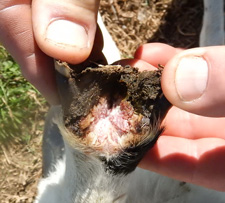A new approach to virulent footrot diagnosis

Footrot in sheep and goats is a challenge for both farmers and regulators but, despite our familiarity with the disease, is a problem that is difficult to pin down. Footrot can present in sheep on a farm along a range of severity, varying from benign (or mild) to severe forms, which are known as virulent footrot. Knowing the severity of the disease in your flock determines how you manage it—for example, you may choose to live with the mild forms with just occasional foot-bathing—but it is imperative that you eradicate virulent footrot from your flock.
Currently, diagnosis of footrot relies first on visual scoring of hoof lesions, which vary depending on environmental conditions and the management strategies you employ to control the disease. So when is 'footrot' really 'footrot'? Here I am referring to the virulent form of footrot.
Is it when the footrot bacterium Dichelobacter nodosus is present? Unfortunately not—that would be too simple. Some strains of the bacterium live happily, causing minimal problems, even on wet sheep feet—these are usually called benign strains. Other strains of the bacterium (called virulent), given the right conditions, cause severe lameness due to damage to the horn of the hoof.
Laboratory tests provide some assistance in sorting out the confusion, but don't provide all the answers. For many years, laboratories have used a two-stage culture process, which first grows the bacteria on one culture medium, then transfers the living bacteria into another medium infused with hoof material, to see if the particular strain attacks the hoof material. This is a long and expensive process, taking around a month from sampling of the hoof through to final results. It also relies on having enough living organisms sampled and staying viable on the way to the laboratory for culturing—this is a challenge with such a delicate bacterium.
A collaborative team of scientists from DEDJTR at AgriBio and La Trobe University at Bundoora is working closely with disease control experts in Victoria, South Australia and Western Australia to develop and validate a new, rapid polymerase chain reaction (PCR) test for the virulent forms of Dichelobacter nodosus.
The PCR test detects two telltale genetic changes in the bacterium that code for benign or virulent activity. The discovery of these markers was first published by a European group of researchers. Having shown promise for many European footrot strains, the method needs to be tested on strains found in Australia.
The PCR test seems to be performing well with Australian strains currently found in the field, and also with historical samples. Although the test is still in the development phase, with fewer than 1000 sheep feet having been swabbed so far, it appears to be correctly differentiating benign from virulent strains. The bottom line at this early stage is that it is working well straight off the foot swab, making it possible to differentiate benign from virulent bacteria within a day of the samples arriving at the laboratory.
More work still needs to be done to confirm the potential of this new test, and I hope to be able to report on progress in 2016.
Grant Rawlin, Research Leader Veterinary Pathobiology, AgriBio